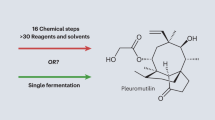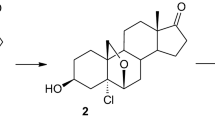Abstract
Labdane diterpenes and their derivatives have shown remarkable biological activities and are useful as chiral building blocks for the synthesis of a variety of bioactive compounds. There is great interest in developing biocatalyst technology to achieve regio- and stereoselective hydroxylation of unactivated C–H bonds in complex natural products, since the functionalization of unactivated C–H bonds generally requires hard reaction conditions and highly reactive oxidizing agents, which are limited regarding the control of regio- and stereoselectivity. Filamentous fungi are efficient biocatalysts capable of catalyzing a wide variety of hydroxylation reactions, and the use of whole cell biocatalysts provides advantages regarding cofactor regeneration and is much less expensive. Therefore, the goal of this study was to select biocatalysts to develop biotransformation processes that can be scalable under mild reaction conditions for hydroxylation of a labdane diterpene, 3β-acetoxy-copalic acid, which contains the trans-decalin moiety and a side chain dienic system appropriate for the preparation of a variety of compounds. Biotransformation processes were carried out and five filamentous fungi were selected as capable of producing hydroxylated diterpenes at positions C-3, C-6, C-7 and C-18 of the trans-decalin moiety and C-13 of the side chain dienic system. Hydroxylation reactions occurred with regio- and stereoselectivity by using some fungi that produced only the 6α, 7α and 13α-hydroxyl derivatives. The chemical structures of the hydroxylated diterpenes were determined from spectrometric and spectroscopic data, and the relative stereochemistry of stereogenic centers was established from coupling constants, by NOE-diff experiments and/or by computational calculations.


Similar content being viewed by others
References
Mafu S, Zerbe P (2018) Plant diterpenoid metabolism for manufacturing the biopharmaceuticals of tomorrow: prospects and challenges. Phytochem Rev 17:113–130
Tran QTN, Wong WSF, Chai CLL (2017) Labdane diterpenoids as potential anti-inflammatory agents. Pharmacol Res 124:43–63
Silva AN, Soares ACF, Cabral MMW, Andrade ARP, Silva MBM, Martins CHG, Veneziani RCS, Ambrósio SR, Bastos JK, Heleno VCG (2017) Antitubercular activity increase in labdane diterpenes from Copaifera oleoresin through structural modification. J Braz Chem Soc 28:1106–1112
Pal M, Mishra T, Kumar A, Tewari SK (2016) Medicinal plants: biological evaluation of terrestrial and marine plant originated labdane diterpenes (a review). Pharm Chem J 50:558–567
Vargas FS, Almeida PDO, Aranha ESP, Boleti APA, Newton P, Vasconcellos MC, Junior VFV, Lima ES (2015) Biological activities and cytotoxicity of diterpenes from Copaifera spp. oleoresins. Molecules 20:6194–6210
Sousa IP, Teixeira MVS, Furtado NAJC (2018) An overview of biotransformation and toxicity of diterpenes. Molecules 23:1387–1418
Frija LMT, Frade RFM, Afonso CAM (2011) Isolation, chemical, and biotransformation routes of labdane-type diterpenes. Chem Rev 111:4418–4452
Rico-Martínez M, Medina FG, Marrero JG, Osegueda-Robles S (2014) Biotransformation of diterpenes. RSC Adv 4:10627–10647
Barrero AF, Herrador MM, Arteaga P, Artega JF, Arteaga AF (2012) Communic acids: occurrence, properties and use as chirons for the synthesis of bioactive compounds. Molecules 17:1448–1467
Mahdjour S, Harche-Kaid M, Haidour A, Chahboun R, Alvarez-Manzaneda E (2016) Short route to cassane-type diterpenoids: synthesis of the supposed structure of benthaminin 1. Org Lett 18:5964–5967
Roh C (2013) Biotransformation for multiple regio-selective hydroxylation of isoflavonoid. Biocatal Agric Biotechnol 2:403–408
Sultana N (2018) Microbial biotransformation of bioactive and clinically useful steroids and some salient features of steroids and biotransformation. Steroids 136:76–92
Mao S, Zhang L, Ge Z, Wang X, Li Y, Liu X, Liu F, Lu F (2017) Microbial hydroxylation of steroids by Penicillium decumbens. J Mol Catal B Enzym 133:S346–S351
Bhatti HN, Khera RA (2012) Biological transformations of steroidal compounds: a review. Steroids 77:1267–1290
Świzdor A, Panek A, Milecka-Tronina N (2017) Hydroxylative activity of Aspergillus niger towards androst-4-ene and androst-5-ene steroids. Steroids 126:101–106
Nassiri-Koopaei N, Faramarzi MA (2015) Recent developments in the fungal transformation of steroids. Biocatal Biotransformation 33:1–28
Felpeto-Santero C, Galán B, Luengo JM, Fernández-Canon JM, Del Cerro C, Medrano FJ, García JL (2019) Identification and expression of the 11β-steroid hydroxylase from Cochliobolus lunatus in Corynebacterium glutamicum. Microb Biotechnol 12:856–868
Cresnar B, Petric S (2011) Cytochrome P450 enzymes in the fungal kingdom. Biochim Biophys Acta 1814:29–35
Donova MV, Egorova OV (2012) Microbial steroid transformations: current state and prospects. Appl Microbiol Biotechnol 94:1423–1447
Pellis A, Cantone S, Ebert C, Gardossi L (2018) Evolving biocatalysis to meet bioeconomy challenges and opportunities. N Biotechnol 40:154–169
Sakkos JK, Wackett LP, Aksan A (2019) Enhancement of biocatalyst activity and protection against stressors using a microbial exoskeleton. Sci Rep 9:3158–3169
Kim CS, Seo JH, Kang DG, Cha HJ (2014) Engineered whole-cell biocatalyst-based detoxification and detection of neurotoxic organophosphate compounds. Biotechnol Adv 32:652–662
Sührer I, Langemann T, Lubitz W, Weuster-Botz D, Castiglione K (2015) A novel one-step expression and immobilization method for the production of biocatalytic preparations. Microb Cell Fact 14:180–188
Klauberg C, Vidala E, Rodriguez LCE, Diaz-Balteiro L (2014) Determining the optimal harvest cycle for copaíba (Copaifera spp.) oleoresin production. Agric Syst 131:116–122
IBGE (2019) Instituto Brasileiro de Geografia e Estatística. https://sidra.ibge.gov.br/Tabela/289. Accessed 18 Oct 2019
Souza AB, Martins CHG, Souza MGM, Furtado NAJC, Heleno VCG, Sousa JPB, Rocha EMP, Bastos JK, Cunha WR, Veneziani RCS, Ambrósio SR (2011) Antimicrobial activity of terpenoids from Copaifera langsdorffii Desf. against cariogenic bacteria. Phytother Res 25:215–220
Rizzatti ACS, Jorge JA, Terenzi HF, Rechia CGV, Polizeli MLTM (2001) Purification and properties of a thermostable extracellular β-D-xylosidase produced by a thermotolerant Aspergillus phoenicis. J Ind Microbiol Biotechnol 26:156–160
Jackson M, Karwoswski JP, Humphrey PE, Kohl WL, Barlow GJ, Tanaka SK (1993) Calbistrins, novel antifungal agents produced by Penicillium restrictum. J Antibiot 46:34–38
Clinical and Laboratory Standards Institute (2017) Reference method for broth dilution antifungal susceptibility testing of filamentous fungi, 3rd.edn. CLSI M-38, Wayne, Pennsylvanian
Frisch MJ, Trucks GW, Schlegel HB, Scuseria GE, Robb MA, Cheeseman JR, Scalmani G, Barone V, Mennucci B, Petersson GA, Nakatsuji H, Caricato M, Li X, Hratchian HP, Izmaylov AF, Bloino J, Zheng G, Sonnenberg JL, Hada M, Ehara M, Toyota K, Fukuda R, Hasegawa J, Ishida M, Nakajima T, Honda Y, Kitao O, Nakai H, Vreven T, Montgomery JAJr, Peralta JE, Ogliaro F, Bearpark M, Heyd JJ, Brothers E, Kudin KN, Staroverov VN, Kobayashi R, Normand J, Raghavachari K, Rendell A, Burant JC, Iyengar SS, Tomasi J, Cossi M, Rega N, Millam JM, Klene M, Knox JE, Cross JB, Bakken V, Adamo C, Jaramillo J, Gomperts R, Stratmann RE, Yazyev O, Austin AJ, Cammi R, Pomelli C, Ochterski JW, Martin RL, Morokuma K, Zakrzewski VG, Voth GA, Salvador P, Dannenberg JJ, Dapprich S, Daniels AD, Farkas Ö, Foresman JB, Ortiz JV, Cioslowski J, Fox DJ (2009) Gaussian 09, Revision C.01, Gaussian, Inc., Wallingford CT
Becke AD (1993) Density-functional thermochemistry. III. The role of exact exchange. J Chem Phys 98:5648–5652
Lee C, Yang W, Parr RG (1988) Development of the Colle–Salvetti correlation-energy formula into a functional of the electron density. Phys Rev B 37:785–789
McLean AD, Chandler GS (1980) Contracted Gaussian basis sets for molecular calculations. I. Second row atoms, Z = 11–18. J Chem Phys 72:5639–5648
Krishnan R, Binkley JS, Seeger R, Pople JA (1980) Self-consistent molecular orbital methods. XX. A basis set for correlated wave functions. J Chem Phys 72:650–654
Ditchfield R (1974) Self-consistent perturbation theory of diamagnetism I. A gauge-invariant LCAO method for N.M.R. chemical shifts. Mol Phys 27:789–807
Wolinski K, Hilton JF, Pulay P (1990) Efficient implementation of the gauge-independent atomic orbital method for NMR chemical shift calculations. J Am Chem Soc 112:8251–8260
Deng W, Cheeseman JR, Frisch MJ (2006) Calculation of nuclear spin − spin coupling constants of molecules with first and second row atoms in study of basis set dependence. J Chem Theory Comput 2:1028–1037
Lodewyk MW, Siebert MR, Tantillo DJ (2012) Computational prediction of 1 h and 13c chemical shifts: a useful tool for natural product, mechanistic, and synthetic organic chemistry. Chem Rev 112:1839–1862
Tomasi J, Mennucci B, Cammi R (2005) Quantum mechanical continuum solvation models. Chem Rev 105:2999–3094
Chen L, Zhu H, Wang R, Zhou K, Jing Y, Qiu F (2008) Ent-labdane diterpenoid lactone stereoisomers from andrographis paniculata. J Nat Prod 71:852–855
Brasil DSB, Alves CN, Guilhon GMSP, Muller AH, Secco RS, Peris G, Llusar R (2008) Crystal structure and theoretical study of IR and 1H and 13C NMR spectra of cordatin, a natural product with antiulcerogenic activity. Int J Quantum Chem 108:2564–2575
Braun B, Breitenbach H (1977) Strukturauflärung einer neuen diterpensäure aus metasequoia glyptostroboides mit hilfe der 13C NMR Spektroskopie. Tetrahedron 33:145–150
Pretsch E, Bühlmann P, Affolter C (2000) Structure determination of organic compounds. Springer, Berlin
Bohlmann F, Knoll KH, King RM, Robinson H (1979) Neue α-santalen- und labdan-derivate. Phytochemistry 18:1997–2002
Grant DM, Cheney BV (1967) Carbon-13 magnetic resonance. VII. Steric perturbation of the carbon-13 chemical shift. J Am Chem Soc 89:5315–5318
Cheney BV, Grant DM (1967) Carbon-13 magnetic resonance. VIII. Theory of carbon-13 chemical shifts applied to saturated hydrocarbons. J Am Chem Soc 89:5319–5327
Parshikov IA, Woodling KA, Sutherland JB (2015) Biotransformations of organic compounds mediated by cultures of Aspergillus niger. Appl Microbiol Biotechnol 99:6971–6986
Lima MAS, Oliveira MCF, Pimenta ATÀ, Uchôa PKS (2019) Aspergillus niger: a hundred years of contribution to the natural products chemistry. J Braz Chem Soc 30:2029–2059
Kelly SL, Kelly DE (2013) Microbial cytochromes P450: biodiversity and biotechnology. Where do cytochromes P450 come from, what do they do and what can they do for us? Philos Trans R Soc Lond B Biol Sci 368:20120476–20120492
Parshikov IA, Modyanova LV, Dovgilivich EV, Terent’ev PB, Vorob’eva LI, Grishina GV (1992) Microbiological transformation of nitrogen-containing heterocyclic compounds. 3. Microbiological synthesis of hydroxy derivatives of 1-benzoylpiperidine and 1-benzoylpyrrolidine. Chem Heterocycl Compd 28:159–162
Burkhead KD, Peterson SW, Bolen PL (1994) Microbial hydroxylation. I. Hydroxylation of aniline by Aspergillus alliaceus, A. albertensis and A. terreus. J Ind Microbiol 13:233–237
Nascimento JS, Núnez WER, Santos VHP, Aleu J, Cunha S, Silva EO (2019) Mapping the biotransformation of coumarins through filamentous fungi. Molecules 24:3531–3539
Parshikov IA, Sutherland JA (2014) The use of Aspergillus niger cultures for biotransformation of terpenoids. Process Biochem 49:2086–2100
Shin J, Kim JE, Lee YW, Son H (2018) Fungal cytochrome P450s and the P450 complement (cypome) of Fusarium graminearum. Toxins 10:112–130
Jakupovic J, Baruah RN, Bchlmann F, King RM, Robinson H (1985) New alicyclic diterpenes and ent-labdanes from Gutierre zia solbrigh. Tethrahedron 41:4537–4544
Lomas JS (2014) 1H NMR spectra of alcohols and diols in chloroform: DFT/GIAO calculation of chemical shifts. Magn Reson Chem 52:745–754
Lomas JS (2014) 1H NMR spectra of butane-1,4-diol and other 1,4-diols: DFT calculation of shifts and coupling constants. Magn Reson Chem 52:87–97
Kutateladze AG, Mukhina OA (2014) Relativistic force field: parametric computations of proton–proton coupling constants in 1H NMR spectra. J Org Chem 79:8397–8406
Lomas JS (2013) 1H NMR spectra of ethane-1,2-diol and other vicinal diols in benzene: GIAO/DFT shift calculations. Magn Reson Chem 51:32–41
Acknowledgements
The authors are grateful to São Paulo Research Foundation, FAPESP, [Grants 2011/13630-7, 2012/01766-4 and 2016/25201-7], Conselho Nacional de Desenvolvimento Científico e Tecnológico, CNPq, [Grants 306345/2016-1, 306441/2017–9, 313648/2018-2], and Coordenação de Aperfeiçoamento de Pessoal de Nível Superior, CAPES, [finance code 001].
Author information
Authors and Affiliations
Corresponding author
Ethics declarations
Conflict of interest
The authors declare that they have no conflict of interest.
Additional information
Publisher's Note
Springer Nature remains neutral with regard to jurisdictional claims in published maps and institutional affiliations.
Electronic supplementary material
Below is the link to the electronic supplementary material.
Rights and permissions
About this article
Cite this article
Cruz de Carvalho, T., de Oliveira Silva, E., Soares, G.A. et al. Fungal biocatalysts for labdane diterpene hydroxylation. Bioprocess Biosyst Eng 43, 1051–1059 (2020). https://doi.org/10.1007/s00449-020-02303-x
Received:
Accepted:
Published:
Issue Date:
DOI: https://doi.org/10.1007/s00449-020-02303-x




